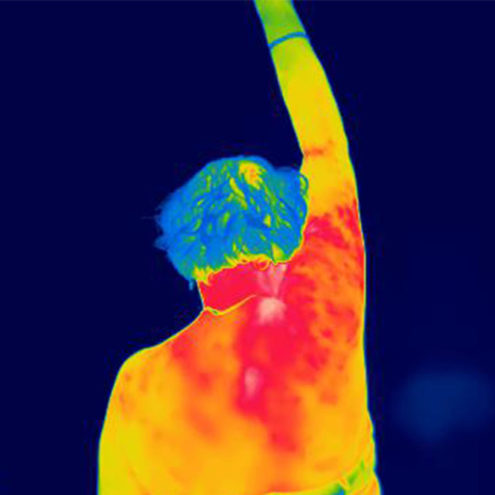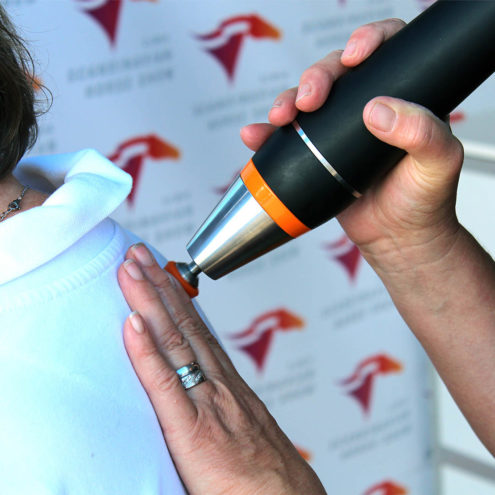Asymmetric load

What is asymmetric loading?
Asymmetric loading is a condition where the body experiences uneven or imbalanced loading on tissues such as bones, muscles, joints, ligaments, etc. Compared to overload, where the load is too high, asymmetric loading means that the weight on our body is distributed unevenly. Imbalance can affect many parts of the body, including the back, neck, shoulders, hips and knees.
When the body is in balance, muscles work in harmony to provide support, stability and mobility. asymmetries occur when some muscle groups are overused while others are neglected. This leads to imbalances and increased strain in certain areas. Several factors, such as incorrect posture, unidirectional physical activity or poor work habits can lead to imbalances.
How does asymmetric load occur?
Asymmetric loading can occur for a variety of reasons. A common cause is that we perform unidirectional activities or movements that overload some muscles or joints while others remain neglected. For example, people who work at desks or perform repetitive movements in their work may experience misalignment of the neck and shoulders due to poor posture for long periods of time.
Imbalances can also occur due to poor exercise habits. Focusing too much on one specific type of exercise or muscle group and neglecting others can create an imbalance in the muscles and lead to imbalance loading. Trauma, injuries or accidents can also cause a sudden imbalance in the body, leading to asymmetric loading.
Symptoms of asymmetric loading
Uneven loading can give rise to different symptoms depending on the areas of the body affected. Symptoms may include pain, stiffness, reduced mobility, muscle weakness or uneven muscle development. A person may experience pain or discomfort on one side of the body, while the other side feels stronger or more engaged.
What should you think about when you have an asymmetric load?
If you suspect or experience symptoms of imbalance, it is important to take care of your body and act to correct the imbalance and relieve the pain. Here are some concrete tips to follow:
Be aware of your posture: Strive to maintain good posture, especially when working and exercising. Make sure to support your back, neck and shoulders correctly to avoid unnecessary strain.
Vary your physical activity: avoid doing one-way activities for long periods. For example, if you spend a lot of time sitting at a desk, it is important to take regular breaks to stretch and activate different muscle groups. It is also important to vary your exercise routine to avoid overuse of specific areas.
Seek professional help: If the pain and imbalance persist or worsen, it is important to seek professional help from a physiotherapist, chiropractor or other musculoskeletal health specialist. They can assess your posture and movement patterns, identify the imbalance, and design an individualized treatment plan to correct the misalignment.
Follow an individualized exercise plan: Based on your assessment and diagnosis, a physiotherapist or specialist can create a customized exercise plan to balance muscles and improve body symmetry. It may include stretching exercises, strength training and movement-based therapy.
Avoid overexertion: Avoid overloading the injured area and give your body enough time to recover. Listen to your body and avoid activities that cause pain or discomfort. Also, use cold or other appropriate methods to relieve inflammation and swelling.
Treatment of asymmetric load
Treatment of asymmetric loading can involve different methods depending on the severity of the imbalance and individual needs. A physiotherapist or specialist can recommend different treatment options to restore balance and relieve pain. Some common treatment methods are:
Physiotherapy: A physiotherapist can perform various treatment techniques, such as stretching, strength training and sometimes manual therapy to improve muscle balance and body symmetry. They can also provide individualized exercises and advice to prevent relapse and promote optimal health.
Chiropractic: A chiropractor may use specific manipulation techniques to correct misalignment and restore the body’s natural balance. These adjustments may focus on the spine and other joints to improve mobility and reduce pain.
Massage and manual therapy: A massage therapist or other manual therapist can use various techniques to release tension and improve circulation in the muscles and connective tissue. This can help to reduce pain and improve muscle balance.
Medical treatment: In some cases, pain and inflammation associated with oblique strain may require medical treatment, such as anti-inflammatory drugs or injections to relieve symptoms and facilitate the healing process.
Fascia treatment for asymmetric load
Fascia therapy has been shown to be effective in treating misalignment and restoring symmetry to the body. The fascia is the network of connective tissue that surrounds muscles, joints and organs, and it plays an important role in providing support, stability and flexibility to the body.
Fascia treatment focuses on removing the tightness and tension that can cause strain and pain. Working on the fascia can promote blood circulation, reduce inflammation and improve the mobility of muscles and connective tissue.
Tne of the benefits of fascia treatment is its holistic approach to the body. Instead of just treating the specific area of pain, fascia theratment addresses the whole body, looking for imbalances and tensions that may be contributing to misalignment. By restoring balance to the fascia, the pain and imbalance in the body can be relieved in a more lasting way.
Frequently asked questions about asymmetric loading
How do I know if I have an asymmetric load?
Identifying asymmetric loading can be tricky as it is not always obvious. Common signs can include uneven muscle development, pain or discomfort on one side of the body and a feeling of using one side more than the other. If you suspect you have an uneven loading , it is best to seek help from a qualified healthcare provider who can assess your condition and give you the right advice and treatment.
How can I correct my asymmetric load?
Correcting asymmetries requires an individualized approach based on your specific situation. A qualified physiotherapist or specialist can help you evaluate your posture and movement patterns, identify the imbalance, and design a customized exercise plan to correct the imbalance. This may include stretching exercises, strength training and other therapeutic methods to restore balance and function to the body.
Can asymmetric loading lead to other health problems?
Yes, untreated imbalances can lead to other health problems in some cases. The imbalance and overload can put extra stress on muscles, joints and ligaments. This can lead to them becoming more stiff and overstretched, which can cause problems such as back pain and poor posture. It is therefore important to take misalignment seriously and seek help to avoid potential complications.
Is fascia treatment effective in treating asymmetric load?
Yes, fascia treatment has been shown to be effective in treating misalignment and restoring the body’s balance. By removing tightness and improving the flexibility of the fascia, fascia treatment can help relieve pain, improve muscle balance and promote optimal mobility and function. Importantly, however, each individual is unique, and consulting with a certified fascia specialist for a personalized assessment and treatment plan is crucial to achieving the best results.
In summary, asymmetric loading can be a challenge that affects the body’s balance, function and well-being. Understanding and treating asymmetries using a ‘fascia-based’ approach can address the underlying causes of imbalance and pain. Combining different treatment approaches, including physiotherapy and fascia treatment, can promote healing, improve muscle balance and regain pain-free mobility. Remember, it is important to seek help from a qualified professional for an accurate diagnosis and individualized treatment plan to best manage the imbalance.
 Search
Search
































